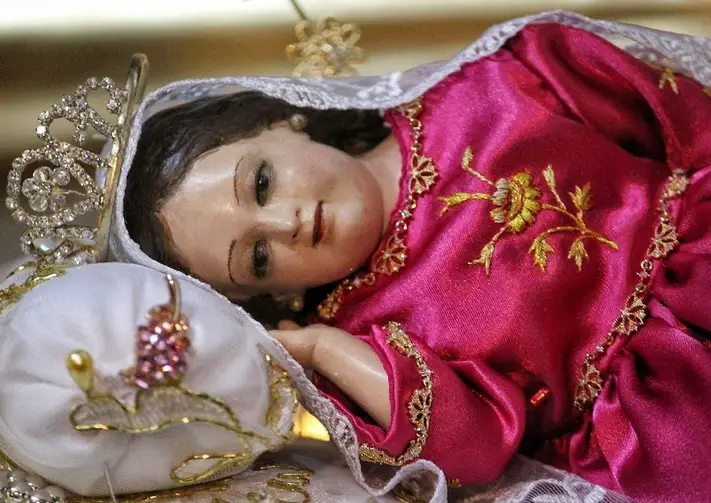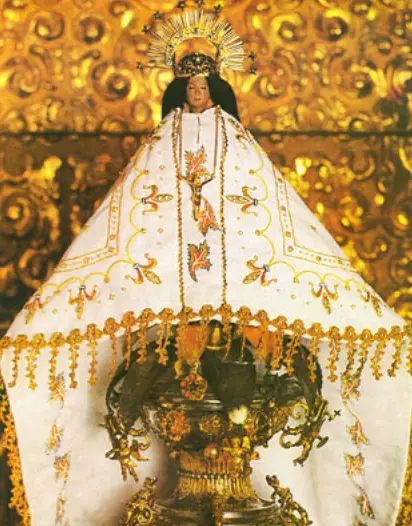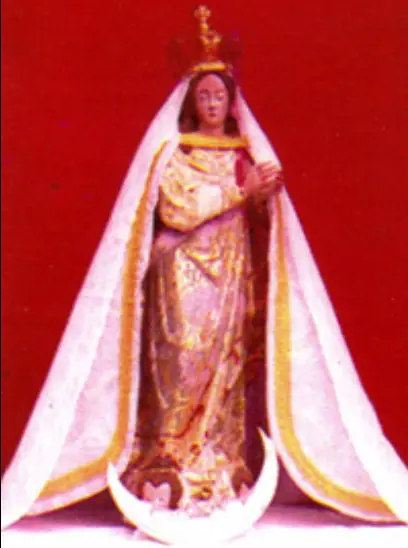Podcast: Play in new window | Download
Subscribe: Apple Podcasts | RSS
This is the fourth part in a series about little-known Virgin Mary images in Mexico. It would be an understatement to declare that religion is a vital part of the lives of most Mexicans. The modern country of Mexico is overwhelmingly Catholic, but some of its beliefs and rituals have foundations in its timeless indigenous past. As in other predominantly Catholic countries, the Virgin Mary, the earthly mother Jesus, plays an important role in the religious lives of Mexicans. Many different apparitions or aspects of the Virgin Mary in Mexico and many shrines devoted to her are known to many people outside the country. In fact, one of the largest religious pilgrimage sites in the entire world can be found in the heart of Mexico itself, in Mexico City, on a hill called Tepeyac. While many millions of visitors from dozens of countries make the pilgrimage to the shrine of the Virgin of Guadalupe every year, there are many smaller shrines and Marian devotions not well-known outside of Mexico or even outside their respective regions within Mexico. Here are three.
- La Divina Infantita
 There are many shrines throughout Mexico devoted to various images of the Baby Jesus, called generically “Santo Niño,” by devotees. Few are aware that there are a handful of holy places in Mexico dedicated to an obscure devotion that began in the mid-1800s, an invocation of the Virgin Mary as a young girl, known as the Divina Infantita, or in English, “The Divine Baby Girl.”
There are many shrines throughout Mexico devoted to various images of the Baby Jesus, called generically “Santo Niño,” by devotees. Few are aware that there are a handful of holy places in Mexico dedicated to an obscure devotion that began in the mid-1800s, an invocation of the Virgin Mary as a young girl, known as the Divina Infantita, or in English, “The Divine Baby Girl.”
At the convent of San José de Gracia in the colonial part of Mexico City a young nun named Sister Magdalena knelt before the manger during the celebrations of the Epiphany. The date was January 6, 1840. Sister Magdalena wondered out loud, “Why don’t we celebrate the birth and childhood of the Mother of God, like we do for her Son Jesus?” While she was reflecting on how to praise the Blessed Virgin Girl, Mary herself appeared to the nun as an infant with a dress of lights, on some clouds. Sister Magdalena leaned back and heard her say: “I will grant all the graces that people who honor me in my childhood ask of me, as it is a much forgotten devotion.” Sister Magdalena was so moved by such an inexplicable event she shared her vision with the other sisters in the convent. The young nun felt the joy of venerating the Infantita, so she asked the Mother Superior, Guadalupe de San Lorenzo, for permission to make an invocation of the apparition she had witnessed and thus fulfill the wish of devotion of the Blessed Virgin Girl. However, the old abbess resisted and needed proof that the apparition was not a delusion of Sister Magdalena. In the meantime, the Mother Superior decided to ignore the requests, thinking if the intention of the Blessed Virgin was authentic, she would have communicated with her directly as she was the head of the convent. A few days later, while Sister Magdalena was cleaning around the chapel, she found a little wooden head of an angel that had been detached from its body. In some versions of the story the angel head blinked its eyes and moved. Sister Magdalena took the head to the Mother Superior and asked her to give her permission to make the image of the Divine Infant with the little head of the angel. The old abbess reluctantly granted her permission. The sisters called in a good sculptor, and Sister Magdalena explained to him what the apparition was like. The sculptor did an amazing job and the image was beautiful and radiant just as the nun had seen it during her vision. Sister Magdalena, full of enthusiasm and joy, began to promote the worship of the Blessed Virgin Infant. This Divina Infantita was responsible for many miracles. Among these miracles were the conversion of a notorious Mexico City criminal and a blind girl who recovered her sight. Sister Magdalena maintained a shrine to the Divine Infant in the cell next to hers at the Convento de San Juan de Gracia. In the cell she had toys, sweets, flowers, etc., and treated her as if she were a living girl. The nun made her novenas with great solemnity, and prepared special ceremonies on her main feast on September 8. Mexico’s main shrines to the Divina Infantita exist in Mexico City, the city of Puebla and in Zapopan, Jalisco.
- The Virgin of Juquila
A very interesting Virgin is housed in a sanctuary in the town of Santa Catarina Juquila, in the state of Oaxaca. Her feast day is December 8th. She is made of wood and stands about 15 inches tall. She wears a tunic, on which the mantle falls off her shoulders and is gracefully draped under the left arm. Her hair spreads over her garment, her hands are clasped over her heart, and her eyes are modestly slanted.
 The town of Juquila was founded by the Mixtec people in the year 1272 AD, but the Virgin that bears the name of the town was not originally from there. The story begins in a town called Amialtepec. A Spanish priest named Fray Jordán de Santa Catarina was assigned to the town of Amialtepec in the mid-1500s. The priest was very dedicated to his parishioners going so far as learning the Zapotec language fluently. Father Jordán served the people of Oaxaca for many decades and would eventually pass away in Spain at the age of 100. In his later years, upon receiving word that he was being recalled to Spain, Father Jordán left a statue of the Immaculate Conception with one of his most faithful indigenous converts. The devout indigenous man made a special place for the Virgin in his hut and the statue drew many visitors from surrounding villages. In the winter of 1633, the people of Amialtepec began burning the grasslands on the hills just outside of town as was customary, to make the soil more fertile for spring planting. The winds picked up and the fires raged out of control, soon engulfing the entire village of Amialtepec. Villagers watched in horror from the ridge as everything they knew burned to the ground. When the fires burned themselves out, the villagers returned to see what they could salvage from the scorched mess. Miraculously, the statue of the Immaculate Conception was untouched and survived the fires completely intact. News spread throughout Oaxaca of this miracle and the higher-up religious authorities made the decision to move the Virgin to the town of Santa Catarina Juquila where they would build an impressive shrine to house her. To this day, tens of thousands of people throughout Oaxaca make the journey on foot to Juquila for the December 8th feast day, some beginning the journey in late November, depending on their distance from the shrine. The Virgin is affectionately known as “La Virgen de Juqui” or simply “Juqui,” and is also sometimes called “La Juquilita.” Pope Francis granted the Pontifical Coronation to the Image in February 2014 and the coronation took place on October 8, 2014. Monsignor Christophe Pierre crowned the image of the Virgin on behalf of Pope Francis. The Virgin of Juquila remains one of the most popular devotions in Oaxaca to this day.
The town of Juquila was founded by the Mixtec people in the year 1272 AD, but the Virgin that bears the name of the town was not originally from there. The story begins in a town called Amialtepec. A Spanish priest named Fray Jordán de Santa Catarina was assigned to the town of Amialtepec in the mid-1500s. The priest was very dedicated to his parishioners going so far as learning the Zapotec language fluently. Father Jordán served the people of Oaxaca for many decades and would eventually pass away in Spain at the age of 100. In his later years, upon receiving word that he was being recalled to Spain, Father Jordán left a statue of the Immaculate Conception with one of his most faithful indigenous converts. The devout indigenous man made a special place for the Virgin in his hut and the statue drew many visitors from surrounding villages. In the winter of 1633, the people of Amialtepec began burning the grasslands on the hills just outside of town as was customary, to make the soil more fertile for spring planting. The winds picked up and the fires raged out of control, soon engulfing the entire village of Amialtepec. Villagers watched in horror from the ridge as everything they knew burned to the ground. When the fires burned themselves out, the villagers returned to see what they could salvage from the scorched mess. Miraculously, the statue of the Immaculate Conception was untouched and survived the fires completely intact. News spread throughout Oaxaca of this miracle and the higher-up religious authorities made the decision to move the Virgin to the town of Santa Catarina Juquila where they would build an impressive shrine to house her. To this day, tens of thousands of people throughout Oaxaca make the journey on foot to Juquila for the December 8th feast day, some beginning the journey in late November, depending on their distance from the shrine. The Virgin is affectionately known as “La Virgen de Juqui” or simply “Juqui,” and is also sometimes called “La Juquilita.” Pope Francis granted the Pontifical Coronation to the Image in February 2014 and the coronation took place on October 8, 2014. Monsignor Christophe Pierre crowned the image of the Virgin on behalf of Pope Francis. The Virgin of Juquila remains one of the most popular devotions in Oaxaca to this day.
- Our Lady of the Defense
The shrine devoted to Nuestra Señora de la Defensa is located in a rural area of the state of Tlaxcala between the hills of the municipalities of Panotla and Totolac. The carved wooden statue of this Virgin is draped in a white cape and topped by a crown. She stands on a crescent moon and holds her hands clasped in prayer, slightly off to her left side. Sometimes her clasped hands hold flowers. She has two times of the year when people are especially devoted to her. The first is the third Sunday and Monday in May. The second is October 12, with festivities beginning 8 days before. The Virgin attracts hundreds of pilgrims during these times. People travel from the nearby states of Hidalgo, Puebla, Morelos and even Veracruz to pray to the image and use the miraculous healing water that flows in the small stream next to the shrine.
 The story of this Virgin begins in the late 1630s in the small shack of a hermit who lived on the spot where today’s shrine now stands. The hermit, named Juan Bautista, lived all alone in the woods, and was a very devout Catholic. He had a special statue of the Conception of the Virgin Mary to which he devoted most of his prayers. Over a 14-month period Juan Bautista noticed many unusual and miraculous occurrences happening in and around the statue. The hermit wondered if he should share the news of these miracles with others, so he eventually told his priest and confessor about the holy relic. The priest asked Juan Bautista if he could write down everything miraculous that he had experienced in connection to the statue. When the hermit returned to his shack, he began writing, and the Devil appeared before him, grabbing his hand and trying to crush it, so he would be unable to write. The hermit invoked the name of the Virgin and the Devil ran away. When Juan Bautista finished his documentation, he gave it all to his priest. The priest passed it along to the Archbishop of Mexico, Juan de Palafox y Mendoza. After reading the document, the archbishop ordered that the statue of the Virgin be removed from the hermit’s shack and transferred to the main cathedral in the City of Tlaxcala. The hermit protested but eventually lived with the decision of the church authorities. Juan Bautista missed his statue so much that he had a duplicate made and let anyone come and visit his shack to pray and leave offerings and to drink the water in the holy stream nearby. He christened the new image Our Lady of the Defense. Soon, the same miracles associated with the statue that had been taken away were occurring in connection to the new image. Word spread, and more and more people started visiting Juan Bautista’s humble hermitage. To the very sick who could not make the pilgrimage, Juan Bautista brought the statue to them, along with water from the nearby stream. He had a 100% success rate in healing people this way. In the year 1662 a ferocious storm hit central Mexico. Juan Bautista, now an old man, prayed to the Virgin to make the rains stop as rivers were overflowing and even the City of Tlaxcala was threatened with total destruction. At the end of his long prayer, a great thunder was heard, and with it the clouds parted. The rivers were contained, the sun came out and the storm was over. Additionally, witnesses testified that a gigantic beam of light shone down on Juan Bautista’s shack. Soon after the hermit’s death a proper shrine was built on the site and has been receiving thousands of devotees since, all looking for a special miracle or to give thanks for blessings received.
The story of this Virgin begins in the late 1630s in the small shack of a hermit who lived on the spot where today’s shrine now stands. The hermit, named Juan Bautista, lived all alone in the woods, and was a very devout Catholic. He had a special statue of the Conception of the Virgin Mary to which he devoted most of his prayers. Over a 14-month period Juan Bautista noticed many unusual and miraculous occurrences happening in and around the statue. The hermit wondered if he should share the news of these miracles with others, so he eventually told his priest and confessor about the holy relic. The priest asked Juan Bautista if he could write down everything miraculous that he had experienced in connection to the statue. When the hermit returned to his shack, he began writing, and the Devil appeared before him, grabbing his hand and trying to crush it, so he would be unable to write. The hermit invoked the name of the Virgin and the Devil ran away. When Juan Bautista finished his documentation, he gave it all to his priest. The priest passed it along to the Archbishop of Mexico, Juan de Palafox y Mendoza. After reading the document, the archbishop ordered that the statue of the Virgin be removed from the hermit’s shack and transferred to the main cathedral in the City of Tlaxcala. The hermit protested but eventually lived with the decision of the church authorities. Juan Bautista missed his statue so much that he had a duplicate made and let anyone come and visit his shack to pray and leave offerings and to drink the water in the holy stream nearby. He christened the new image Our Lady of the Defense. Soon, the same miracles associated with the statue that had been taken away were occurring in connection to the new image. Word spread, and more and more people started visiting Juan Bautista’s humble hermitage. To the very sick who could not make the pilgrimage, Juan Bautista brought the statue to them, along with water from the nearby stream. He had a 100% success rate in healing people this way. In the year 1662 a ferocious storm hit central Mexico. Juan Bautista, now an old man, prayed to the Virgin to make the rains stop as rivers were overflowing and even the City of Tlaxcala was threatened with total destruction. At the end of his long prayer, a great thunder was heard, and with it the clouds parted. The rivers were contained, the sun came out and the storm was over. Additionally, witnesses testified that a gigantic beam of light shone down on Juan Bautista’s shack. Soon after the hermit’s death a proper shrine was built on the site and has been receiving thousands of devotees since, all looking for a special miracle or to give thanks for blessings received.
REFERENCES
Spanish-language Wikipedia
